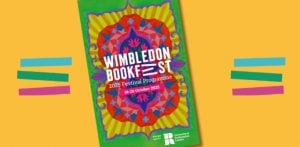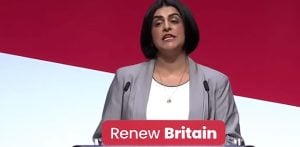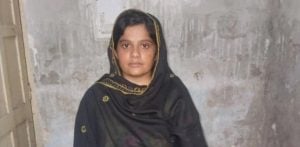"We need to abolish the idea that Desis can’t be depressed"
Anika Hussain is a growing presence within literature as her tales span identity, love, and now, mental health.
Hailing from Stockholm, Sweden, Anika relocated to the picturesque streets of Bath, Somerset, where she graduated from the esteemed Bath Spa MAWYP.
Her debut work, This Is How You Fall in Love, not only enthralled audiences with its charm as a YA rom-com but also marked a groundbreaking shift towards representation within the genre.
Anika’s narratives stand as mirrors, reflecting the experiences of those who have long yearned to see themselves within the pages they hold.
However, her latest venture, Desi Girl Speaking, slightly steers away from the traditional confines of YA tales.
Here, Anika leads readers through the trials and tribulations of dealing with mental health issues, especially in South Asian communities.
The compassionate novel focuses on Tweety, a 16-year-old grappling with depression, lost in isolation and misunderstanding.
As her issues worsen, she receives a lifeline through the podcast Desi Girl Speaking.
With such a vivid look at mental health and mirroring the real-life scenarios that many South Asians face across the world, the novel hopes to spark wider discussions of these stigmatic topics.
DESIblitz spoke to Anika Hussain about the importance of such a book, her personal experiences with mental health, and how we can break the taboo surrounding this problem.
How did the book sensitively shed light on mental health issues?

My aim for the novel is to educate without sounding condescending or blaming the community.
To do this, I had to educate myself further on why there is such a stigma surrounding the issues rather than making unfounded accusations.
I’ve read a lot of YA books about mental health and found that hugely beneficial in how previous authors have tackled the subject without triggering their readers or scaring people off about speaking about mental health entirely.
I was also conscious of the fact that this story is primarily aimed at teens rather than adults who have the power to help them.
As such, I needed to write in such a way that wasn’t overly statistical, lecturing or fear-mongering but rather highlighting the ups and downs of what it means to live with a mental illness.
My agent and editor were also hugely beneficial in guiding me as I wrote Tweety’s story, ensuring that the story was told with sensitivity and authenticity.
Can you share any experiences that motivated you to write about mental health?
I personally struggle with depression and have been doing so since my early teens.
What I found that I lacked at that time was any books with South Asian main characters who also struggled with mental illness.
“I read a lot of books about mental illness but couldn’t find myself identifying with the journeys I read.”
It was the lack of representation and the need to feel like there was someone out there like me that inspired me to write Desi Girl Speaking.
At 15, Desi Girl Speaking was the book I would have needed to feel like I wasn’t out of my mind for feeling the way I did.
One that might have got me to access the help I deserved sooner rather than later.
In what ways do you hope your novel will impact readers?

I hope for my South Asian readers that it will fill them with some sort of comfort knowing that they are not the only ones who are suffering and that their pain is valid.
I also hope it will give them the strength to speak to those around them.
The book can be used by families as a reference that highlights Desi stories of mental health and they can be openly spoken about even though they may be severely underreported.
I hope it gives them courage.
For my non-South Asian readers who may be struggling, I hope that, even though the culture may be different to theirs, they might see their journey represented.
Tweety’s journey isn’t specific to the South Asian experience, even though much of the discussion and fears she has around it is.
I hope readers can find comfort in knowing that there are other cultures or families just like hers.
How did you go about crafting Tweety’s character?
It was important throughout the drafting process that I created her in such a way that she didn’t come off as someone who didn’t actively try to help herself or constantly blamed those around her.
That meant putting a lot of time and effort into crafting the people around her.
Tweety is who she is and thinks the way she does about mental illness because of the people around her and their insistence that depression doesn’t exist for Desi people.
It was through using the characters around her that I was able to create a Tweety that was both self-aware and lost at the same time.
“Someone who didn’t blame but also didn’t fully understand why nobody was listening to her.”
For me, crafting Tweety meant making her like any other human, making her empathetic, funny, and loveable with the added trait of a mental illness.
Especially as that is how I imagine a lot of people who struggle with mental illness to be; just like other people with something weighing them down.
What inspired you to include the podcast element in the narrative?

I love listening to podcasts and find that I will always put one on, whether that be when I’m going for a walk, cooking, or just playing something on my phone.
I also think the current generation, Gen Z, uses it as a tool to decompress while also educating themselves.
Gen Z are so incredibly great at tackling the issues that matter to them most and they do so openly and unabashedly.
For the ones who aren’t yet ready to use their voice, it’s a way for them to support those who do and feel like they can understand their feelings further on a particular topic.
In some ways, it’s more accessible and time-efficient than reading because you can have information fed to you while performing another task.
How do you see the relationship between Tweety and Desi Girl evolving?
Tweety’s relationship with Desi Girl is incredibly superficial at first, as most online friendships are, but throughout they get to the nitty-gritty of it all, leaning on each other when they need it most.
There is something freeing about spilling your guts out to someone while there is a screen between you.
“Because of that, their relationship evolves quicker.”
As humans, I think relationships develop significantly quicker by sharing the darkest parts of you, hoping that the other person will accept you for who you are.
At the same time, that type of relationship isn’t sustainable at all, and I think that’s particularly clear for both of them as the book progresses.
What challenges did you face in ensuring authentic representation?

The hardest part about writing a YA novel about a South Asian character dealing with mental health was trying not to vilify or paint the people in her life or the community around her as bad people.
In the book, Tweety constantly feels like nobody in her life understands her along with the fact that they don’t want to understand her but that’s not the case at all.
Rather, it’s deeper than the idea of not wanting to understand and help her, which Tweety only finds out later down the line.
Another challenge was trying to ensure that there was a representation of mental illness that was authentic for both characters.
But at the same time, I had to signal to readers that their stories are not the blueprint of what mental illness in South Asian people looks like but are rather one depiction of what it may look like.
Can you discuss how ‘speaking up’ unfolds throughout the story?
For Tweety, dance has always been the way she expressed her feelings.
As her depression deepens, she loses the very thing that gave her not only a voice but meaning.
As dance becomes something she is no longer able to use, she has to decide how she can navigate her own emotions without the very thing she used to rely on.
Tweety tries out journaling as an outlet but finds that it doesn’t give her the comfort she is so desperately seeking.
“When she finds Desi Girl’s podcast, it’s like the world has opened up for her.”
Even though she is not the one speaking, she finds reassurance in somebody else’s words, feeling heard for the first time since she started feeling like something was wrong with her.
As the story progresses, Tweety’s voice grows louder in the way she writes to Desi Girl along with the actions she takes, physically harming herself.
The significance of using one’s voice in this case isn’t limited to simply using it verbally but also how we use it physically to showcase to the world how it is we feel and what we need.
At the end of the novel, both girls find that they have been using their voices not in the way that is most conducive to the change they desire and team up together to use it with intent and purpose.
What research did you undertake to ensure accuracy in portraying mental health issues?

I read a lot of blog posts about South Asian people who have suffered first-hand with depression along with scientific journals and research papers.
The research was imperative because although I have depression myself, I am not an expert on the matter.
I can only tell my story but there are thousands of stories out there, each detailing one aspect of the illness.
I also read journals on writing about mental health for young teens to ensure that I was handling the matter sensitively without triggering readers or encouraging them in any sort of way as there are some scenes where self-harm is present.
What motivated the shift to a more serious topic like mental health for your second book?
Mental health is a topic I am very passionate about and Tweety’s story has been with me for years, itching to be told, so it was a no-brainer for me that, should I get the opportunity to tell it, I do.
I enjoy writing romcoms and love sharing them with the world because I think South Asian people deserve their joyful stories to be told too.
“But I hope that I can also share more stories that are slightly more serious.”
I hope one day that both my romcoms and serious stories can co-exist in the same space because life isn’t just one or the other, it’s both at the same time.
You can be in love and have fun with your friends and family all the while struggling with something deeply debilitating.
How has the Hawkins Project influenced you?

The Hawkins Project has been so insightful to me as a writer.
I’ve seen first-hand how the kids have responded to various types of manuscripts, whether that be what they would like to see more character-wise, stylistically, or even plot-wise.
At the end of the day, I write for young people.
I would be foolish to not take into consideration what type of books and stories they would like to read.
As such, the Hawkins Project has influenced my work by making me more acutely aware of what it is our young people want to read rather than what it is that their parents and school districts might want them to read.
If we want children and young people to feel more empowered in the stories that are told, we need to give them the platform to do so, which is exactly what the Hawkins Project sets out to do.
How does your novel contribute to understanding mental health?
I hope it can help start conversations about mental health and that when people hear of South Asian teens expressing their feelings, they listen with intent and without judgement.
I think Desi Girl Speaking can be the book that teens can reach for when they’re struggling to express their pain.
“It’s also a book that parents and teachers alike can use to identify symptoms in young people.”
It can make people reconsider their biases and stigma about mental illness in the community and re-examine how they go about speaking to those around them about the matter.
How do you envision mental health becoming less stigmatic?

I envision that, more than anything, the community needs to speak about mental health and acknowledge that it exists and that it can affect just about anybody.
Otherwise, there is no way that we can normalise its presence and reduce the stigma surrounding it.
We need not be afraid to use our voices.
I am hoping that Desi Girl Speaking and the current generation of youths will be able to help in this fight, in helping the community understand that the very thing they have feared for so many generations isn’t something to be feared at all.
As a community, we need to abolish the idea that Desis can’t be depressed and treat it the same way you would any other disease because mental illness is not a choice or a death sentence.
You can be perfectly healthy, successful, loved and still have a mental illness.
Anika Hussain’s writing is centred around a passionate plea for compassion and understanding, reflecting both her own experiences and the voices she works to elevate.
Anika urges readers to travel on a journey of reflection and camaraderie via Tweety’s story.
Whilst Desi Girl Speaking hones in on important issues, the wider conflicts between South Asians and mental health need to be discussed.
As Anika mentions, there needs to be a push in communities to present the real stories and experiences of those dealing with mental health issues.
Desi Girl Speaking by A.S. Hussain is published by Hot Key Books and will be available at all good bookshops on May 9, 2024.





























































